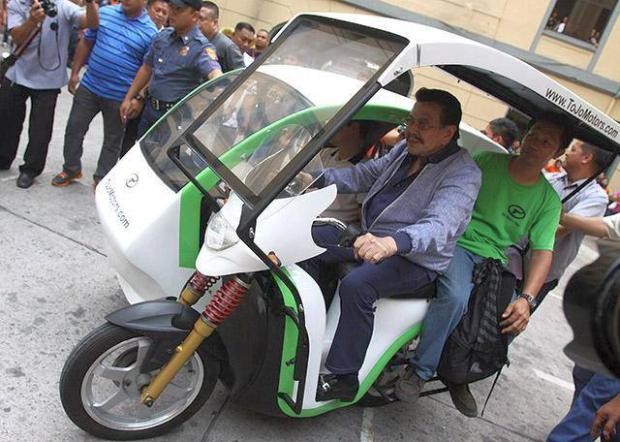Estrada distributes first 50 units in Manila e-trike program
Manila Mayor Joseph “Erap” Estrada distributed on Wednesday morning the first 50 units in his electric tricycle (e-trike) program to driver beneficiaries in Binondo.
The first batch of beneficiaries were all residents of District 3, which has been chosen as the pilot site of for the project. Besides Binondo, the district also covers Quiapo, San Nicolas, and Santa Cruz.
“This is primarily a livelihood program with the main objective of providing our poor tricycle and kuliglig (motorized pedicabs) drivers an ‘upgraded’ public transport vehicle which they can call their own and from which they could earn more,” Estrada said in a statement.
“Driver-operator na sila in a matter of four years,” he added.
E-trikes will be financed through a “boundary-hulog” system, wherein the driver-owners will pay P150 boundary daily for five years directly to the Officeo f the City Treasurer. The city government will also subsideze the cost of charging their e-trikes’ batteries.
Article continues after this advertisementThe project is also one of the means to reduce air pollution and improve the livelihood of some 1,500 legally franchised tricycle drivers in the city.
Article continues after this advertisementThere are about 25,000 colorum tricycles, pedicabs, and kuliglig, operating in the city.

This photo, posted on the Facebook page of Joseph Estrada on Oct. 11, 2016, the mayor of the nation’s capital tries out an e-trike. (Photo from Estrada’s Facebook page)
Estrada said the city government would procure thousands more of the e-trikes to gradually replace fuel-run tricycles.
E-trikes will have exclusively franchised routes to avoid compettition with tricycles with internal combustion engines, according to Dennis Alcoreza, chiefot the Manila Traffic and Parking Bureau (MTPB).
E-trikes will also be introduced in Malate, Ermita, and the University Belt.
So far, the city government has bought 280 e-trikes, costing P100,000 each, for distribution this year. An e-trike be fully charged in four to five hours. It runs at a top speed of 40-45 kilometers per hour and can carry up to six passengers.
The Manila Electric Co. (Meralco) has constructed several charging stations, the first one in Binondo.
“This project is entirely a livelihood program para sa masa. The city of Manila is not intending to profit from this livelihood program unlike other institutions,” Alcoreza said. “We just want to provide to the poorest of the poor to earn more in order for them to improve their kind of living.” /atm